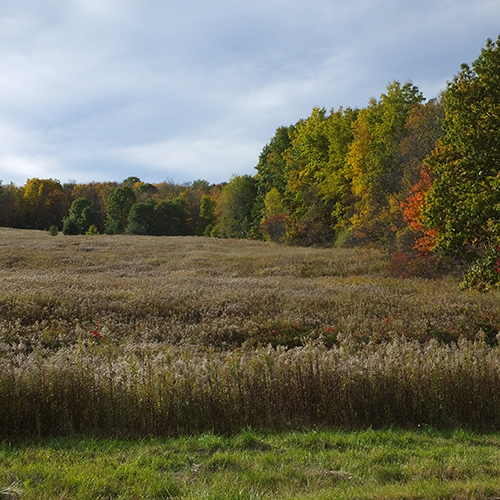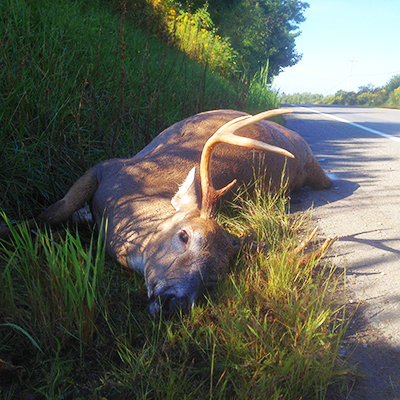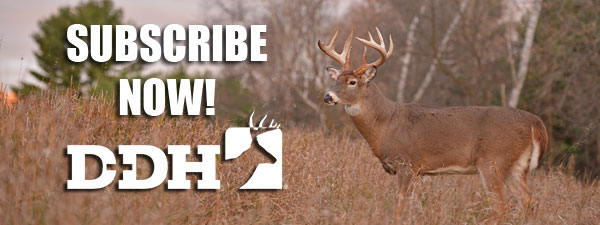D+DH In-Depth is our premium, comprehensive corner on America’s No. 1 game animal. In this graduate-level course, we’ll teach you about deer biology, behavior, and ultimately, how to become a better hunter. Want to be the first to get our premium content? Become a D+DH Insider for FREE!
Deer habits, deer needs and our habits — they all converge to create autumn carnage on our roads.
By Steve Sorensen
No one wants to see an airborne doe with bulging eyes heading right for the windshield, even if she does end up sailing right over the car. And no one feels good about driving a four-wheel drive truck over a fawn in the middle of the night, breaking her back, even though there’s virtually no damage to the truck. I was the driver in both examples. Hitting deer is dangerous, costly and sickening.
Deer pose one of the greatest risks to drivers all across America. In states with high deer populations, Interstate highways are littered with them. They lie along rural roads too, sometimes a few steps from the family mailbox. People make jokes about a deer bagging a driver, but it’s no joke. The Insurance Institute for Highway Safety tells us that each year about 200 people die because they were in a car that collided with a large animal, usually a deer.
One mid-October evening my wife and I were heading for church where our men’s and women’s Bible study groups were meeting. Suddenly a deer was within whiskers of my driver’s side door. In her effort to avoid my Grand Cherokee she fell onto the centerline of the roadway. I watched in my rearview mirror as a second deer stumbled into the first. Fortunately, both deer were unharmed.
That close call prompted my wife to ask why so many deer seem to have death wishes in October and November. I quickly rattled off eight reasons. I went way beyond the standard “rutting bucks” explanation to some I had never thought of before. I’ve driven roughly a million miles and have hit (or been hit by) at least a half dozen deer. I guess I’ve had a lot of time to think about it.
1. Rutting Bucks
We start with the obvious. Most bucks 2 years old or older know the rut is coming. Their testosterone is rising in anticipation as they sniff out does and look for places the girls hang out. The rut is their most vulnerable time of the year. The urge to reproduce transforms reclusive bucks into risk-takers. They don’t fully understand it, which makes them seem stupid. Rutting bucks charge into the paths of lots of cars, and chase lots of does across roadways. Safe driving requires acute awareness, whether in very rural areas or the outskirts of big cities.

2. Free-wheeling Fawns
The reproduction spectrum includes much more than rut-crazed bucks. The sexual energy in bucks that avoided our shiny vehicles last year produced offspring. All summer the mothers have done their best to guard their young from dangers, but by October the fawns are bigger, stronger and more independent. Their mothers have less control over them, but they’re not yet smart. Those big chunks of steel whizzing by at 55 miles per hour mean nothing to footloose and fancy-free fawns. Oblivious to danger, they sprint onto the blacktop and into our paths in the fall more than any other time.
3. Buck Dispersal
Most hunters know that bucks disperse to new territory. Most drivers don’t know. When we see a young buck in October and November, he may feel lost and confused because yearling bucks disperse. The reason? Genetic purity requires distance between young bucks and their mothers to prevent inbreeding. Some left their mothers in the spring. Others leave in the fall. All these young bucks wearing their first set of antlers are on the move. They’re becoming familiar with the home range they’ve chosen, or they’re still looking for new digs. At this stage of life, they’re learning where they fit. These scattered young bucks can easily get intercepted by cars.
4. Seasonal Menus
As the seasons change, restaurant menus often change too. It’s no different in the whitetail world. The biology of deer digestion forces deer to a new seasonal menu. Stomach enzymes change to prepare deer for a dead-of-winter diet that includes woody growth and dried leaves. The final crop of hay has been harvested and new growth is less tender than after earlier cuttings. Deer still eat grasses and clover in fall, but less of that and more of autumn’s smorgasbord of acorns and other mast. Corn is being harvested, and in some cases the farm machinery chases deer out of the cornfields and into the paths of our cars. Fall dietary changes force deer to find new food sources that will sustain them through the rut and the long winter.

5. Winter Wardrobes
As fall menus change, so do wardrobes. Deer have lost summer’s reddish look. Goldenrod has dried up and turned from green and yellow to brown. Fawns have become spotless brown miniatures of their mothers, less visible to us because they blend in better with their surroundings. It’s hard to imagine a more perfectly camouflaged animal than a brown whitetail deer standing in brown goldenrod in October and November. Most vegetation growing along the roadway has also turned brown. Autumn’s color change means deer are much less visible than they were a few short weeks ago. You won’t see them until they’re right in front of you.
6. Cooler Temperatures
Deer also take advantage of the comfort delivered by the dropping mercury. Their new winter coats mean they move less in the heat, and more when the thermometer drops. On 90-degree days, deer are content to stay on their bellies until their need for food overcomes the desire for comfort. Fall’s 50- to 40-degree temperatures are much more tolerable for deer. Like people, they’re inclined to move around more when they can be comfortable. Hunters get excited when a cold front moves in. Drivers should see a cold front as the time to be more cautious.
7. Busy People
Bug-infested woods are unpleasant in summer’s heat, so people who are in the woods confine themselves mostly to campground retreats and recreational shores of lakes and rivers. Things change after the first hard frost. Most bugs have died off and people are busy looking at the brilliant fall colors and hiking the outdoors. Without question, more people invade deer habitat in the fall than they did in the summer, and the fall flurry of last-chance camping excursions, checking trail cameras, hiking, walking dogs and more, prompt deer to move.
8. Driving Routines
The tilt of the earth robs the northern hemisphere of daylight hours and brings falling temperatures. By our reckoning, the deer seem to be moving earlier, but not by their reckoning. What matters to deer is not the position of the hands on the clock, but the position of the sun in the sky. That means as the days get shorter, our evening driving hours intersect more with the time deer tend to be moving. With dusk coming earlier (jumping a whole hour when daylight savings time ends), it’s no wonder deer pop out along the roads more while we’re driving.
The nation’s leading auto insurer, State Farm, says we had 1.23 million deer-vehicle collisions in the United States between July 1, 2011, and June 30, 2012, at a cost of more than $4 billion in vehicle damage, an average of about $3,300 per incident.

Ways to Avoid Deer
Hunters care not only about the dollars but about the deer, and our knowledge of deer habits should help us hit fewer of them. Beyond recognizing why we hit them, we must also take a few precautions:
- Observe habitat along roadways, note the kinds of areas where deer are likely to be, and understand that they can show up anywhere.
- Driving glasses with yellow lenses really do help. By providing better contrast, they make everything more visible during transition hours when it’s harder to see.
- Check to see if brighter headlights are available for your vehicle. If they are, install them.
- With the sun low in the sky, glare on the windshield becomes more of an issue. Simple things, like washing the inside of your windshield, can prevent collision with a deer.
- While driving, force your eyes to scan the berm and the brush that lines the ditch on both sides of the road. Check for shadows and eyeshine. Realize that deer in these places can enter the road as though they come from nowhere.
- What’s the hurry? Just because the speed limit is 55 doesn’t mean you can’t drive at 45 or even slower. Reduce your speed. You’ll see deer sooner, and hit fewer of them.
- Change your driving habits. To the extent possible, don’t drive at the times when deer are moving.
- If you see one deer, slow down and watch for more. If mama has already crossed, her impulsive fawn might panic and dash out in front of you to join her.
- Realize that those yellow, diamond-shaped deer crossing signs mark only a few of the hundreds of areas where deer cross roads.
- Fill your doe tags. You can’t know for sure, but killing a deer might save a life.
Steve Sorensen, aka “The Everyday Hunter®” is an avid deer hunter from Pennsylvania.
Want to be the first to get our premium content? Become a D+DH Insider for FREE!


